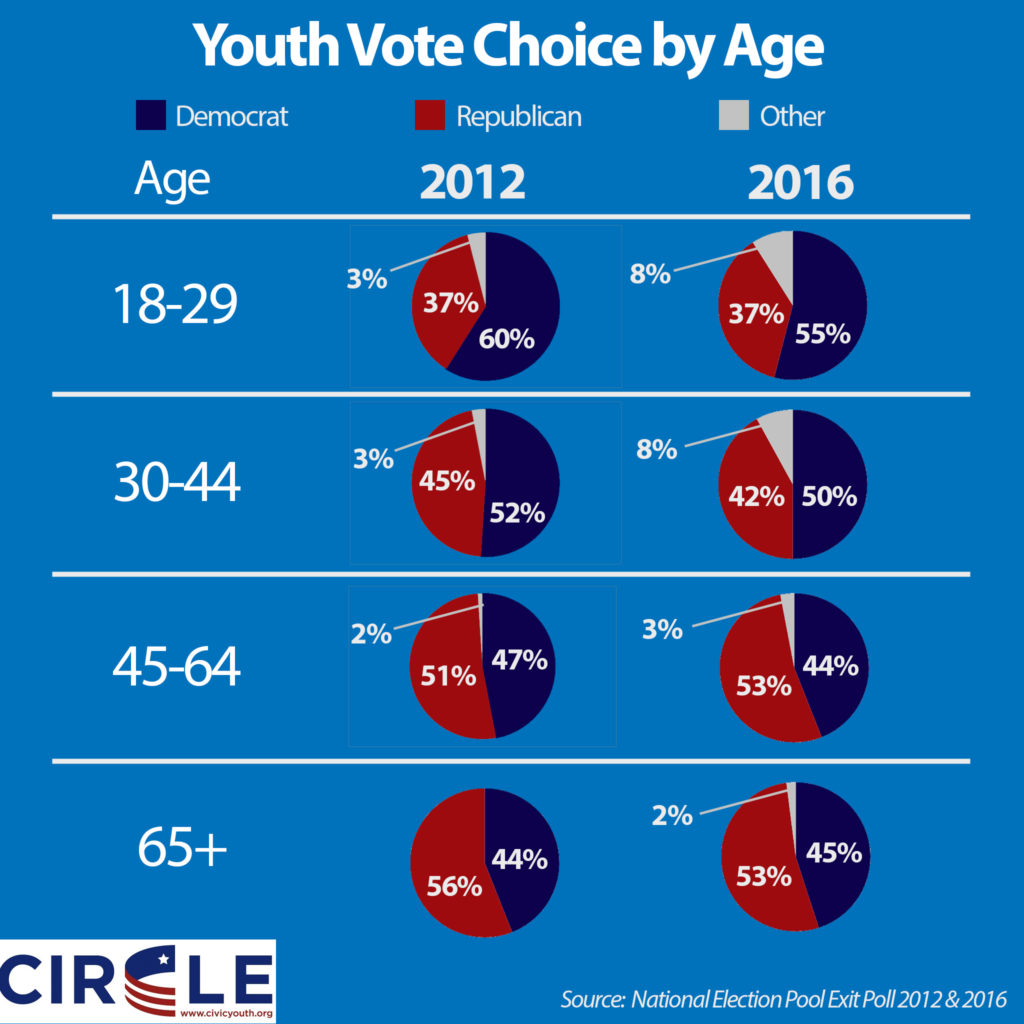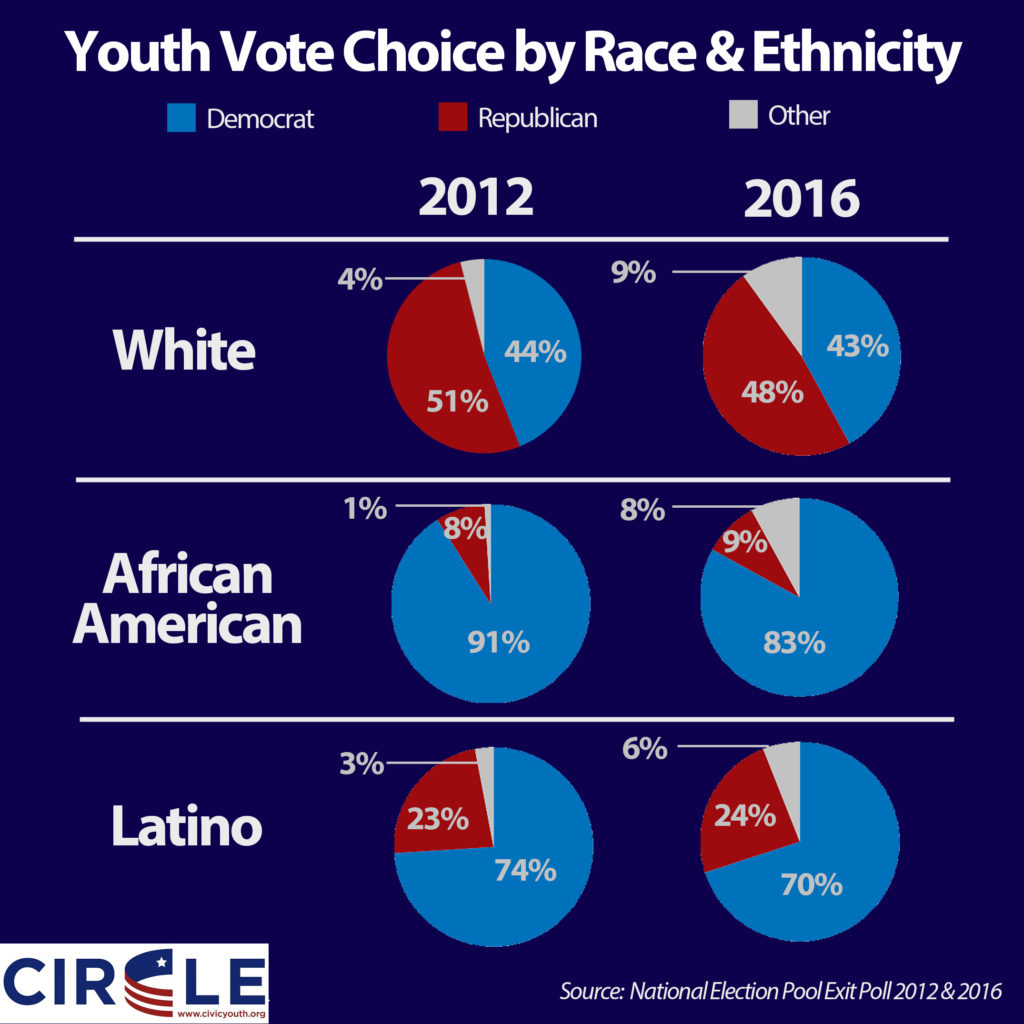Election Night 2016: 24 Million Youth Voted, Most Rejected Trump
Note: The following analyses were written in the hours and days immediately following the 2016 presidential election and reflect the best available data and estimates at that time.
Young voters made their voices heard in Tuesday’s presidential election, making up one-fifth of the electorate, and almost two-thirds of them rejected Donald Trump’s candidacy for president even as older Americans seem to have coalesced around the Republican nominee and propelled him to an unexpectedly victorious electoral performance. As in other recent electoral processes, such as the “Brexit” vote on the United Kingdom’s status in the European Union, young people voted drastically differently than older segments of the electorate but may have come up short in definitively shaping an outcome in an election that they believed would affect them personally.
As of this writing (November 9), we estimate that 23.7 million young voters participated in the 2016 presidential election, a 50% voter turnout of citizens aged 18-29 in the United States.1 Young voters supported Hillary Clinton over Donald Trump by 55% to 37%. We estimate that 13 million youth voted for Secretary Clinton and almost 9 million youth voted for Donald Trump. Among young people of color, Clinton won by even more decisive margins. An additional 2 million young people either voted for third-party candidates or chose not to vote for any of the Presidential candidates on the ballot.
While we produced a preliminary national turnout estimate of 50% based on best-available data, it is vital to note that there can be dramatic differences in youth voter turnout by state. By another measure of youth participation, youth vote share (the proportion of all votes cast by young people) in a majority of the 28 states where exit polls were conducted youth made up an equal or larger share of the electorate than senior citizens: higher in 14 states, and tied in three.
Nationally, young voters aged 18-29 cast 19% of all votes in the 2016 presidential election, which is the same as the youth share of voters in 2012.

Youth Vote Choice & Differences by Race
Our pre-election poll of Millennials ages 18-34 had Clinton 49% vs. Trump 28%, a 21-point preference for the Democratic candidate. The National Exit Poll suggests that the actual split in the election was 55% for Clinton to 37% for Trump (an 18-point gap) among youth aged 18-29.
The 37% youth support for the Republican candidate in 2016 equals the support garnered by Mitt Romney in 2012. However, youth support for the Democratic candidate dropped: it was 60% for President Obama’s reelection in 2012, and 55% for Clinton this year. Notably, while in the last presidential election 97% of young voters chose one of the two major party candidates, this year only 92% did so, as nearly 1 in 10 youth (8%) selected a third-party option or otherwise eschewed voting for Clinton or Trump.
The percentage of youth supporting the Democratic candidate was lower than in both of President Obama’s elections, and closer to the level achieved by Bill Clinton in his successful 1996 campaign. It’s the third highest share of the youth vote for Democrats since 1972. Meanwhile, the 37% support from young voters was the fourth-lowest for a Republican candidate since 1972.
As we highlighted in our CIRCLE pre-election poll of Millennials, young people were sharply divided by race, and those differences manifested on Election Day. Youth of color supported Hillary Clinton by wide margins, 70% to 24% among young Latinos and, even more dramatically, 83% to 9% among young African Americans. However, Trump won among young Whites, 48% to 43%, a modest margin that may have nonetheless made a big difference in battleground states with large White populations, such as Iowa (where 84% of young citizens are white) and Ohio (78%). Both states were called for Trump late Tuesday night.
Throughout the election season, our analysis has emphasized the demographic and ideological heterogeneity of Millennials, contradicting facile generalizations that characterize them as the “Obama generation.” In particular, there are regularly stark differences in ideology and issue positions among Millennials of different races, genders, and socioeconomic status.
Nationally, compared to 2012, youth support for Republicans remained relatively constant among Whites (-3 points), African Americans (+1 point), and Latinos (+1 point). The national exit poll suggests that there were more youth in 2016 who supported a third-party candidate, did not vote for a presidential candidate, or specifically chose not to answer this poll question. White youth have been markedly less likely than youth of color to support Democratic candidates. This year, 43% of young Whites voted for Clinton, while Black youth supported her by almost double that margin (83%). However, it’s worth noting that young African Americans were notably less likely to support Clinton in 2016 (83%) than Obama in 2012 (91%).

Youth Shaped the Race in Key States
Our analysis of margin of victory in relation to estimated youth turnout and choice revealed that young voters played an important role in keeping some key races very close. If it were not for young voters’ support for Hillary Clinton, electoral college votes in Michigan, New Hampshire, and Nevada would have gone more decisively to Donald Trump. Michigan and New Hampshire are currently too close to call in part because of the edge that young voters gave Clinton in those states.
- In Nevada, Hillary Clinton won by an estimated 26,000 votes. Youth decisively favored Clinton in Nevada (52% to 35%), and this resulted in a net gain of 35,000 votes for Clinton. If young people had voted in equal number for Donald Trump and Hillary Clinton, Clinton’s victory would have been by an even narrower margin of less than 10,000 votes.
- In Michigan, which was too close to call on Election Night and Trump ended up winning by less than 12,000 votes, young voters’ decisive support played a major role in keeping the race close. Youth favored Hillary Clinton by over 232,000 votes (57% to 34%). If young voters’ support for her had been even slightly less decisive, Donald Trump would have won the state handily.
- In neighboring Wisconsin, young voters gave Clinton a 4-point advantage (47% to 43%). Notably that’s much less enthusiastic support for Clinton than the 30-44 age group (54% to 37%). Trump won Wisconsin by less than one 1 percentage point.
- In New Hampshire, also too close to call on Election Night, young voters were absolutely decisive. Youth gave Clinton a net of 12,000 by favoring her 49% to 41%, and she won the race by less than 4,000 votes.Young voters were the only group that gave a significant edge to Clinton.
- On the other hand, in Iowa, which Trump won by a comfortable margin, young voters were evenly split between Trump and Clinton, who both received 45%. The youngest voters (ages 18-24) favored Clinton 51% to 39%, while voters aged 25-29 favored Trump by a sizable margin.
The Youth Electorate: More Young White Men, College Graduates
Our analysis of the national exit poll suggests that the 2016 youth electorate had similar levels of racial and ethnic diversity as the 2008 and 2012 youth electorates. At the same time, the 2016 youth electorate had a higher percentage of youth with at least some college education than in those two previous elections. Finally, young white men made up a larger proportion of the white youth electorate than young white women, which had not been the case in recent elections.
The 2016 youth electorate (ages 18-29) was 61% White, 15% African-American,17% Latino, 5% Asian-American, and 3% other. In contrast, the 30+ electorate this year was 73% White.
Despite a general belief that whites were over-represented in the 2016 electorate as a whole, the youth electorate (ages 18-29) was racially representative of the population of young citizens in that age group and no less diverse than the youth electorates in 2008 or 2012, which were themselves more diverse than the 2004 youth electorate. However, while the overall racial composition of the youth electorate was very similar to that of recent elections, there were important shifts in which segments of White youth went to the polls more than in recent presidential cycles.
Notably, exit poll analysis suggests that young White men were more influential this year than they have been in recent elections. In 2004, 2008, and 2012, the share of young White men in the electorate lagged behind that of young White women. In 2016, however, we estimate that young White men cast 1 million more votes than in 2012: from 6.8 million to 7.8 million. They far outnumbered young White women who cast an estimated 7 million ballots—roughly the same as in 2012 but below the estimated votes from 2004 and 2008.
Within that gender shift, there were particularly stark differences by educational attainment. In 2008, young White women without a college education made up 34% of the young White electorate. This year, they made up just 24% in 2016, while the share of all other gender/education segments of the White youth electorate has gone up.
The most dramatic shift was the increase in the share of young White women with college degrees, who made up just 19% of all young White voters in 2008, but this year equaled young women without college degrees at 24%. At the same time, the share of young White male voters has gone up regardless of educational attainment, but the rate of increase also appears to be slightly greater for men with college degrees.
There are multiple possible explanations for these changes. For one, President Obama’s first campaign in 2008 mobilized then-college students and young Millennials who may have become committed voters once they completed their studies. On another note, during the primaries, 25 to 29-year-olds were more supportive of Secretary Clinton, and targeted outreach may have focused more heavily on this older segment of youth who are more likely to have already completed college.
A More Educated Youth Electorate
In addition, while much has been made of Donald Trump’s ability to motivate non-college educated voters, that does not seem to have been the case in 2016—at least among youth. In fact, it appears to have under-mobilized those who have never gone to college in this election; they made up less than 20% of the youth electorate even though there are twice as many “non-college youth” in the general population.
The electoral overrepresentation of youth with higher levels of formal education has been an enduring pattern. This year, we recorded the lowest share of youth without any college experience in the past four elections, and a nearly 10-point drop from 2012.
[1] CIRCLE estimates youth voting after elections based on several variables, including the total number of ballots counted and the exit polls. These variables are subject to change in the hours and days after an election. In several states, less than 95% of precincts have reported their votes. Also, in some past years, the national exit polls conducted by Edison Research have adjusted their statistics in the first few days after an election.


